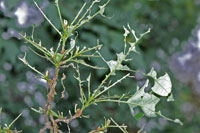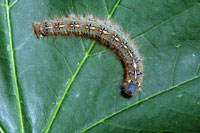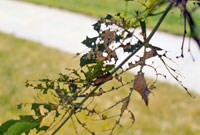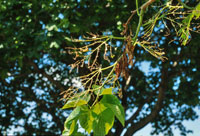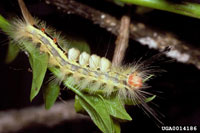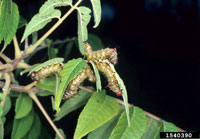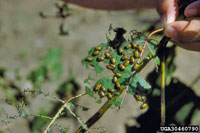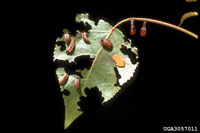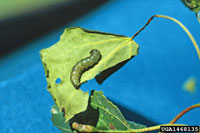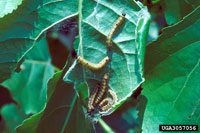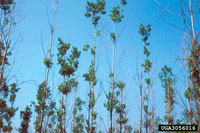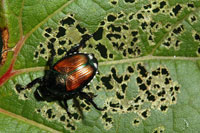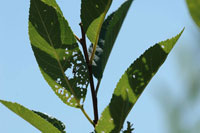Extension > Garden > Diagnose a problem > What's wrong with my plant? > Deciduous Trees > Poplar > Holes in leaves or parts of leaves missing
Poplar > Leaves > Holes in leaves or parts of leaves missing
1 of 7
Forest tent caterpillar
Malacosoma disstria
- Larvae chew entire sections of leaves, defoliating branches and trees when populations are high
- Blue and black with characteristic footprint shaped white markings on top of body
- Damage occurs May and June
- More information on Forest tent caterpillar
2 of 7
Whitemarked tussock moth
Orygia leucostigma
- Young larvae windowpane feed (i.e. feed on one layer of leaf tissue between veins) giving them a lacelike
- Older larvae consume entire leaves except the midrib and large veins
- Caterpillars have a red-orange head with two sets of black tufts near the head; yellowish hairy body with distinct tufts of hair resembling a toothbrush on top of the body
- Full grown larvae are 1 ¼ inches long
- Damage by 2 generations, first from May to June and a second one from August to September
- More information on Whitemarked tussock moth
3 of 7
Redhumped Caterpillar
Schizura concinna
- Larva will eat entire leaf, leaving only the
- Red head and a wavy black, yellow, and white striped body with a red projection (hump) on the thorax behind the head, 1 1/3 inch long when fully grown
- Occurs in August and September
- More information on Redhumped Caterpillar
4 of 7
Cottonwood leaf beetle
Chrysomela scripta
- Adults eat leaf margins and create "shot-holes" in leaf tissue
- Larvae windowpane feed, i.e. feed on the upper leaf surface between the veins
- Defoliation can occur when populations are high
- Adults are ¼ inch long with yellow and black stripes
- Larvae are black when young and have 2 white dots on either side
- More information on Cottonwood leaf beetle
5 of 7
Large aspen tortrix
Choristoneura conflictana
- Larvae first drill holes into leaf buds causing holes in leaves
- Skeletonized leaves are webbed or rolled together in spring
- In early summer, canopy becomes sparse due to consumed and smaller leaves
- Larvae are nearly black in color, approximately 3/4 inch long with a black head
- Quaking aspen is preferred host
6 of 7
Poplar tent maker
Clostera inclusa
- Chews entire sections of leaves
- Leaves strung loosely together with webbing or silk
- When fully grown, larvae are up to 1 3/15 inch long; four yellow stripes down center of body with yellow lines along side opposite of black lines
- Damage occurs during spring with a second generation occurring in late summer
- More information on Poplar tent maker
7 of 7
Japanese beetle
Popillia japonica
- Skeletonizes leaves, i.e. chews leaf tissue between the veins creating a lacelike appearance
- Attacks are common in sunny locations starting at the top of the plant and working down as they feed
- Adults are metallic green; bronze wings; white tufts of "hair" along their sides
- Beetles present as early as late June and are active through September
- More information on Japanese beetle



